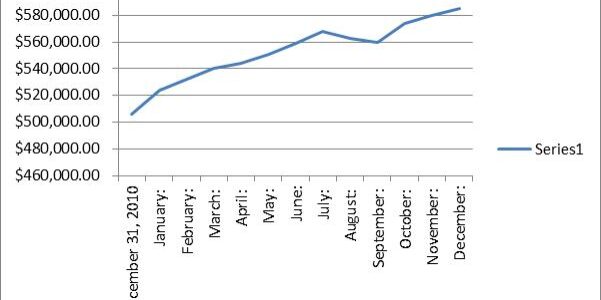Smith Manoeuvre Portfolio – December 2010
For those of you just joining us, below is my portfolio that is leveraged with money borrowed from my home equity line of credit (HELOC). As the money borrowed is used to invest, the interest charged is tax deductible. I write an update every so often to show new positions added along with any market gains/losses. For more details on the strategy and procedure, check out my modified smith manoeuvre strategy and my comparison of online stock brokers.
Since the last June 2010 update, very little has changed in the portfolio as bargains have been challenging to find. I did manage to find one position to add to, and what was Mullen Group (TSE: MTL) where 50 shares were added. The best performer of the year was First Capital Realty (FCR) and the worst performer was by far Manulife Financial (MFC).
Overall with the markets going up in 2010, the rising tide resulted in a gain in this portfolio which I’m pleased with. As we have our house paid off, our home equity line of credit now has a lot of room to move. I plan on keeping the investment loan balance and even increase it should the opportunity arise.
My dividend watch list hasn’t changed much since my last couple reports. I am looking to increase my position in T.BMO, T.TD, T.ENB, T.FCR and new positions in T.CNR T.L and T.BPO (new on the list) when their valuations become attractive. What’s also interesting are income trusts that will be soon converting to corporations. It’ll give this portfolio a few more choices.
If you are a dividend investor, which income trusts are you interested in?
The Portfolio as of December 2010:
| Stock | Symbol | Shares | Avg Buy Price | Total | Div/Share | Yield |
| Royal Bank | RY.T | 75 | $47.62 | $3,571.25 | $2 | 4.20% |
| CIBC | CM.T | 45 | $67.14 | $3,021.25 | $3.48 | 5.18% |
| Power Financial | PWF.T | 105 | $35.14 | $3,689.65 | $1.40 | 3.98% |
| Scotia Bank | BNS.T | 105 | $41.91 | $4,400.52 | $1.96 | 4.68% |
| Manulife Financial | MFC.T | 125 | $33.12 | $4,139.48 | $0.52 | 1.57% |
| Fortis Properties | FTS.T | 150 | $25.63 | $3,843.98 | $1.04 | 4.06% |
| TransCanada Corp | TRP.T | 100 | $33.50 | $3,349.74 | $1.52 | 4.52% |
| AGF Management Limited | AGF.B.T | 50 | $22.71 | $1,135.49 | $1.00 | 4.40% |
| Bank of Montreal | BMO.T | 25 | $44.17 | $1,104.24 | $2.80 | 6.34% |
| Husky Energy | HSE.T | 135 | $32.53 | $4,391.27 | $1.20 | 3.69% |
| TD Bank | TD.T | 50 | $48.24 | $2,412.23 | $2.44 | 5.06% |
| Enbridge | ENB.T | 40 | $37.36 | $1494.39 | $1.48 | 3.96% |
| TransAlta | TA.T | 50 | $21.47 | $1073.49 | $1.16 | 5.40% |
| First Capital Realty | FCR.T | 160 | $9.72 | $1,574.99 | $0.80 | 8.23% |
| Canadian Utilities | CU.T | 50 | $36.40 | $1,819.99 | $1.41 | 3.87% |
| Ensign Energy Services | ESI.T | 100 | $13.81 | $1,380.99 | $0.35 | 2.55% |
| Mullen Group | MTL.T | 100 | $14.54 | $1,453.98 | $0.50 | 3.44% |
More Stats
- Total Cost Base of Equities (inc. fees): $43,837.14
- Market Value of Equities (Dec 10, 2010): $48,143.90
- Total Dividends / Year: $1,859.23
- Portfolio Dividend Yield: 4.24%
Sector Allocation (based on market value)
- Financials: 51.51%
- Utilities: 17.87%
- Energy: 25.58%
- Resources: 0.00%
- Real Estate: 5.03%
- Other: 0.00%
With regards to sector allocation, you may notice that this portfolio is fairly concentrated in financials. Note though that this is one of my accounts where I treat all of my accounts as one big portfolio. In other words, my international and other sector equity exposure are in other accounts.
Disclaimer: There have been a lot of readers who have mentioned that they are interested in a leveraged portfolio. Over the long term it may be lucrative. However, over the short term, equities are volatile and can put the portfolio deep in the red. My portfolio over 2008 is a prime example of what can happen. If you can’t stomach losing 20-30% in the portfolio in any given year, then your risk tolerance isn’t suited for leveraged investing. Here is an article I wrote answering a reader question “Should I Start the Smith Manoeuvre?” Finally, the securities mentioned in this post are not recommendations to buy or sell.
I've Completed My Million Dollar Journey. Let Me Guide You Through Yours!
Sign up below to get a copy of our free eBook: Can I Retire Yet?





Are these returns of yours
“Total Cost Base of Equities (inc. fees): $43,837.14
Market Value of Equities (Dec 10, 2010): $48,143.90”
factoring in what you paid in interest, claimed as a deduction and received back as a ‘tax rebate’ included in this amount? Wasn’t sure if thats what ‘inc fees’ included?
based on your above calculations it looks like with your 43% or so tax bracket its likely that loan is -1.71% drag on return with interest rates where they are? Would that make a real dividend yeild more like 2.53%?
I am in the praries (MB), but i thought that if your only income was dividends you could have a much higher income ($90k) before paying any large amount of tax… assuming 0 other income and all Canadian dividends.
Your holdings are heavy financial and missing some other good alternative trusts: YLO, ARE, NWF, RSI, ACO.X, SC, ECA, RON, CLC. Of course not all are super attractive right now, but most are worth addign to watch lists.
Ever thought of buying bank preferred vs actual shares?
thanks
Ah yes that did help. (I read it in the past but it sure helps to read it a couple more times). Also Qcash’s portfolio.
More great posts in the year to come!
@FMB, this article on portfolio allocation may help.
I read the couch potato portfolio, and that makes some more sense. Helps to have it cleared up. I want to fully understand what I am doing, before I do it. Sure I learn from mistakes, but why not make it someone else’s mistakes? :)
non reg account = canadian dividends
RSP = US Dividends
TFSA = ?
I still need to do some more research before making any buys obviously. Just trying to see the maximum benefits of each type of investment holder.
What would you reccomend reading to help clear this up for me?
Example: Which investments to hold in a tfsa, in an RSP, or in a non reg account?
Thanks a million (or more)
AndrewF. Duly noted. Thx. My bad.
Thanks for the post… an interesting read. Hey, have you thought about updating your comparison of Canadian discount brokerages? I’d be interested in seeing the new figures.
Your choices are interesting! The yield on your investments probably cover the net interest you are paying on your HELOC. In spite of that, I don’t like the idea of using borrowed money to make investments. To be more specific, using a HELOC to fund stock market investments bothers me. If you can sleep at night, good for you.
QCash:
Just a mild correction. FT has an article on this topic. You have RRSP and TFSA flipped. In TFSA, US dividend payers still have 15% with-holding tax that does not apply in RRSP. So US dividend payers are better in RRSP and fixed income in TFSA.
@QCashMan, lol, yes indeedy. I’m guessing that your portfolio has rebounded nicely since the lows of 2009? Did you buy more BMO at the bottom?